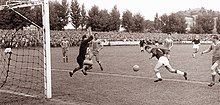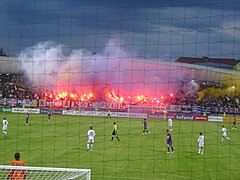NK Maribor
In addition, the club is one of the two founding members of the Slovenian PrvaLiga (along with Celje) which have never been relegated from the league since the inaugural 1991–92 season.
[13] During their five-year stay in Yugoslav's top division, the club played a total of 166 league matches and achieved 40 wins, 57 draws and 69 defeats.
[18] The club nearly returned to the top tier in 1978–79 when they finished as runners-up of the second division, six points behind Bosnian side Čelik Zenica,[19] but failed to win the promotion play-offs.
[20] After the scandal and the subsequent relegation, Maribor spent the following years bouncing between the second and third Yugoslav divisions until Slovenia's independence in 1991.
Following Slovenia's independence in June 1991, Maribor were one of the founding members of the newly formed Slovenian First League for the inaugural 1991–92 season.
[28] The final match of the season was played on 1 June 1997 against Beltinci in front of 14,000 spectators,[29] which is also a joint-record of the Slovenian top division.
[48] Furthermore, Maribor also won two back-to-back doubles in this period, beating Celje on both occasions in the 2012 and 2013 Slovenian cup finals.
[52] In the next season, they again qualified for the group stage, and managed to win four points after defeating Panathinaikos and drawing with Tottenham Hotspur, both at home.
[53] In their third consecutive appearance in the group stage, in 2013–14, Maribor advanced to the knockout phase of the 2013–14 UEFA Europa League for the first time.
[55] Their successful European run was upgraded in the 2014–15 season, when Maribor finally qualified for the UEFA Champions League group stage for the second time in their history, after eliminating Celtic in the play-offs.
[61] In the same season, Maribor failed to win a trophy for the first time since 2007–08, losing the league title to Olimpija on head-to-head record after finishing with the same number of points.
[75][76] However, because many football teams in Yugoslavia already wore red and white jerseys, Maribor officials decided for a new and fresh combination.
[68] Oto Blaznik, the first captain of the club, was the one who suggested the combination after seeing the Italian team in La Gazzetta dello Sport.
[85] The badge is formed in a shape of a shield, and shows the former Piramida Castle that used to stand on top of the Pyramid Hill before it was demolished at the end of the 18th century.
[86] Unlike the coat of arms of the city of Maribor, the club's current badge does not represent a white dove facing down towards the castle, but a minimalist portrayal of a person.
[86][87] Since 1992, the club's official anthem has been the song "Heja, hej Viole", which was written and composed by the band Čudežna polja.
[90] Previously, the club played a very short period of its early history at Stadion ob Tržaški cesti.
It is considered a natural, cultural, architectural and sports landmark of the city and is named after a public park previously located in the area.
[100] In addition to being the home ground of Maribor, the stadium also occasionally hosts matches of the Slovenia national football team.
[101] The record attendance of the stadium is 20,000 spectators, achieved in 1973 when Maribor played against Proleter Zrenjanin in the Yugoslav Second League promotion play-offs, while the record for a Slovenian League match is 14,000 spectators, achieved in the last round of the 1996–97 Slovenian PrvaLiga season.
[102][103] In addition to the city of Maribor and its surroundings, the club also has a large fan base in Styria and Carinthia, with smaller groups of supporters also present in other parts of Slovenia.
[124] The first derby between Maribor and the newly formed club was played on 24 October 2007 in the quarter-finals of the Slovenian Cup.
[130] Note: Flags indicate national team as defined under FIFA eligibility rules; some limited exceptions apply.
Note: Flags indicate national team as defined under FIFA eligibility rules; some limited exceptions apply.
[134] In May 2021, the club retired another squad number, 33, in honour of goalkeeper Jasmin Handanović, who made over 350 appearances for Maribor between 2011 and 2021.
[135] In May 2022, the number 9 was retired in honour of Marcos Tavares, a longtime captain and the club's all-time most capped player and top goalscorer.
[140] Since the establishment of Maribor's youth system in its present form in 1990, the academy has been one of the most successful in the country in terms of titles won.
[139] In 2012, a record eight Maribor players were called to the Slovenian under-17 national team for the 2012 UEFA European Under-17 Football Championship.
[145][146] In 2016, the youth team of Maribor participated in the fourth edition of the international children's social programme Football for Friendship, the final events of which took place in Milan.
[148] The Purple Warrior (Vijol'čni bojevnik) is a trophy awarded to the most distinguished player of the year with the best attitude towards the fans and the club.






